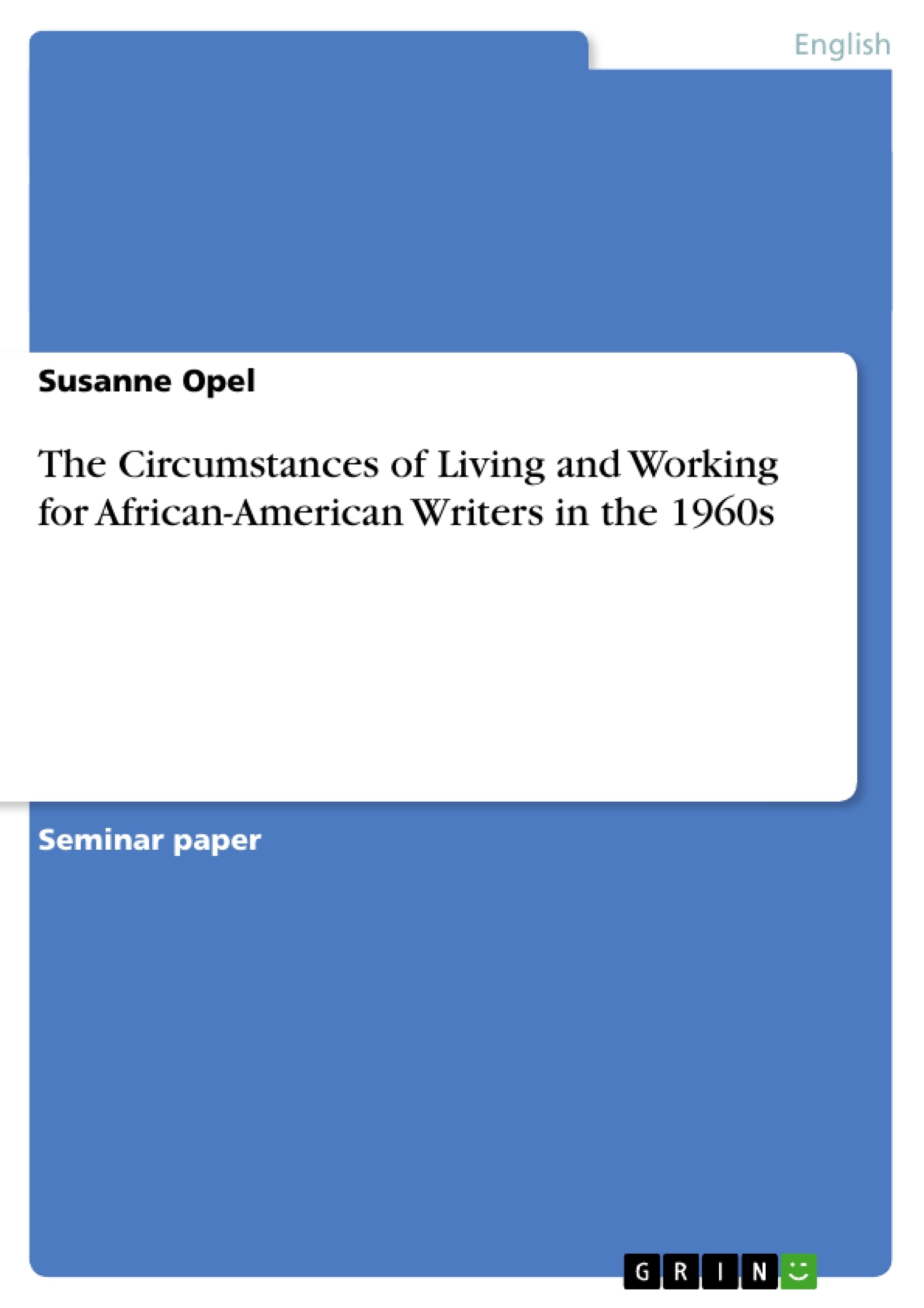The 1960s were a decade of changes for everyone in the USA. The Civil Rights Movement was at its height, while the assassinations of important personalities such as John F. Kennedy and Malcolm X, as well as Vietnam and the Cold War overshadowed the lives and thoughts of a whole generation. Hippie Culture, the anti-war movement, and the sexual revolution created a whole new generation with a new set of values. For the arts, for culture, and for the sciences the 1960s were a period of new developments that influenced the following decades immensely: the Beatles, worldwide TV shows, or the first man on the moon, just to name a few.
Compared to their peers of periods, adolescents and unmarried young adults of the 1960s enjoyed greater social freedom and mobility and also were less tolerant of the socio-political subjugation of black people.
The 1960s were also the decade in which African-American literature reached a new climax after the Harlem Renaissance in the twenties. There were a lot of new possibilities for African-Americans, but still also a lot to fight for. Being an African-American writer was a constant struggle, not only to earn money to survive , but also to gain the same acceptance as a white writer, or to help change something for the other African-Americans. Chester Himes wrote in his essay Dilemma of the Negro Novelist in U.S. (1966):
From the start the American Negro writer is beset by conflicts. He is in conflict with himself, with his environment, with his public. The personal conflict will be the hardest. He must decide at the outset the extent of his honesty. He will find it no easy thing to reveal the truth of his experience or even to discover it. He will derive no please from the recounting of his hurts. He will encounter more agony by his explorations into his own personality than most non-Negroes realize. For him to delineate the degrading effects of oppression will be like inflicting a wound upon himself. He will have begun an intellectual crusade that will take him through the horrors of the damned. And this must be his reward for his integrity: he will be reviled by the Negroes and whites alike. Most of all, he will find no valid interpretation of his experiences in terms of human values until the truth be known. If he does not discover this truth, his life will be forever veiled in mystery, not only to whites, but to himself; and he will be heir to all the weird interpretations of his personality.
Inhaltsverzeichnis (Table of Contents)
- I. A special Decade in African-American Cultural History
- II. A short historical Outline of African-American Literature
- III. Life in the black communities
- 1. Everyday Life
- 2. Education
- 3. Religion
- IV. Fighting for more rights
- V. Black Cultural Centres and Organizations
- 1. The Black Arts Movement
- 2. African-American theatres
- 3. The reception of African-American art in the 1960s
- VI. Being an African-American writer in the 1960s
Zielsetzung und Themenschwerpunkte (Objectives and Key Themes)
This paper examines the circumstances of living and working for African-American writers during the turbulent 1960s. It aims to explore the various factors that influenced their lives and work, specifically highlighting the impact of the Civil Rights Movement, the rise of the Black Arts Movement, and the role of religion within the African-American community.
- The influence of the Civil Rights Movement on African-American literature.
- The impact of the Black Arts Movement on the creative expression of African-American writers.
- The significance of religion and its role in shaping the lives and work of African-American writers during this period.
- The challenges and opportunities faced by African-American writers in the 1960s, including issues of racial discrimination, financial hardship, and the pursuit of recognition.
- The evolution of African-American literature from its early stages to the rise of the modern period.
Zusammenfassung der Kapitel (Chapter Summaries)
Chapter I explores the 1960s as a period of significant change in the USA, marked by the Civil Rights Movement, the assassinations of John F. Kennedy and Malcolm X, the Vietnam War, and the cultural revolution of the Hippie movement. It highlights the unique challenges and opportunities faced by African-Americans during this decade, particularly within the realm of literature.
Chapter II provides a historical overview of African-American literature, tracing its evolution from its early stages of slave narratives and folk literature to the emergence of the modern period with the Harlem Renaissance. This chapter outlines the literary contributions of notable African-American authors and explores the themes and experiences that have shaped this distinct body of literature.
Chapter III delves into the lives of African-Americans in their communities, examining everyday life, education, and the role of religion within the black community. It explores how these aspects influenced the worldview and perspectives of African-American writers during the 1960s.
Chapter IV examines the ongoing fight for racial equality and the various forms of activism that characterized the Civil Rights Movement. This chapter explores how the struggle for social justice provided African-American writers with a platform for their voices, and how their works contributed to the broader movement for equality.
Chapter V explores the rise of Black Cultural Centers and Organizations, focusing specifically on the Black Arts Movement. This chapter examines the role of African-American theatres and the reception of African-American art within the broader cultural landscape of the 1960s.
Schlüsselwörter (Keywords)
Key terms and concepts explored within this text include African-American literature, the Civil Rights Movement, the Black Arts Movement, Harlem Renaissance, racial discrimination, social justice, cultural identity, religious influence, and the challenges and opportunities faced by African-American writers in the 1960s.
- Quote paper
- Susanne Opel (Author), 2004, The Circumstances of Living and Working for African-American Writers in the 1960s, Munich, GRIN Verlag, https://www.grin.com/document/42610




